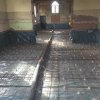I'm refurbishing an old School Building. It has 9" solid brick walls.
We are building an inner timber 'skin' that will
A. Take the load of a mezzanine floor above (taking advantage of the height of the School), to give us a second floor.
B. Allow us to comply with Thermal Regs
C. Give us some straight walls as the existing brick walls are a bit all over the place.
The wall structure is (from outside to inside)
220mm Bricks (Imperial)
50mm Air Gap
100mm Sawn/Treated Timber (4 x 2 at 400 centres)
between the Studs 100mm Rockwool
Vapour membrane 500g or more
Celotex / Eco Therm (to meet regs)
12.5mm Plasterboard.
The floor is a poured re-inforced concrete slab. As such we will drill through the sole plate and fix to the floor (packers to ensure level) we have a double top plate as we are putting 175 x 50 (170 x 47) Floor Joists.
My question is....
I need to fix the timber wall to the brick wall to give lateral support - especially around existing window reveals to ensure a good, solid structure.
However, I cannot see a metal product specifically for this purpose. As, we essentially need an L shaped bit of metal with a drip point at the mid-point. Or at worst, an L shaped bit of metal we can put in at an angle, ensuring any moisture runs away from the timber.
Any help or advice would be REALLY appreciated.
We are building an inner timber 'skin' that will
A. Take the load of a mezzanine floor above (taking advantage of the height of the School), to give us a second floor.
B. Allow us to comply with Thermal Regs
C. Give us some straight walls as the existing brick walls are a bit all over the place.
The wall structure is (from outside to inside)
220mm Bricks (Imperial)
50mm Air Gap
100mm Sawn/Treated Timber (4 x 2 at 400 centres)
between the Studs 100mm Rockwool
Vapour membrane 500g or more
Celotex / Eco Therm (to meet regs)
12.5mm Plasterboard.
The floor is a poured re-inforced concrete slab. As such we will drill through the sole plate and fix to the floor (packers to ensure level) we have a double top plate as we are putting 175 x 50 (170 x 47) Floor Joists.
My question is....
I need to fix the timber wall to the brick wall to give lateral support - especially around existing window reveals to ensure a good, solid structure.
However, I cannot see a metal product specifically for this purpose. As, we essentially need an L shaped bit of metal with a drip point at the mid-point. Or at worst, an L shaped bit of metal we can put in at an angle, ensuring any moisture runs away from the timber.
Any help or advice would be REALLY appreciated.





